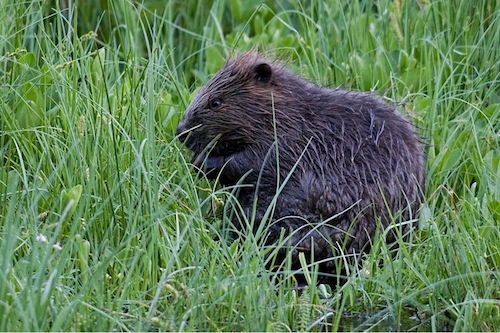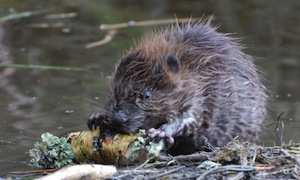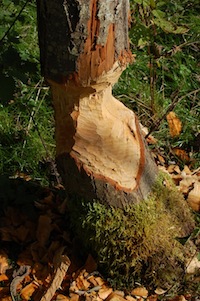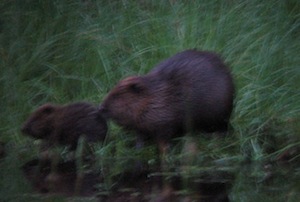Here at LWON we’re celebrating the holiday week by bringing back some of our favorite posts. This post originally appeared in July 2013.
 The Ramsay family has lived at the Bamff estate, 1300 acres of heathery hills and woodlands in eastern Scotland, for nearly eight centuries. Today, environmentalists Paul and Louise Ramsay share the property with three families of beavers. The couple brought the animals to Bamff in 2002 as part of a controversial effort to reintroduce European beavers, which hunters eradicated from Scotland some 400 years ago. I spoke to the Ramsays about dams, wetland conservation, the spread of wild beavers, and a mysterious snake potion.
The Ramsay family has lived at the Bamff estate, 1300 acres of heathery hills and woodlands in eastern Scotland, for nearly eight centuries. Today, environmentalists Paul and Louise Ramsay share the property with three families of beavers. The couple brought the animals to Bamff in 2002 as part of a controversial effort to reintroduce European beavers, which hunters eradicated from Scotland some 400 years ago. I spoke to the Ramsays about dams, wetland conservation, the spread of wild beavers, and a mysterious snake potion.
How did the Ramsay family acquire the estate?
PAUL: It wasn’t acquired by violence and blows but because an ancestor in the 13th century, described in the original charter as Master Neish, was the physician to King Alexander II. He did some good service to the king, partly as an advisor.
I read that there’s a slightly more fantastical origins tale. Can you tell me the story?
LOUISE: The story is that Neish studied medicine under a wizard, who demanded that he capture a white snake in a cave behind a waterfall called the Reekie Linn. So he scaled the cliff and waited in the cave until the third night of the full moon, when he  managed to grab the snake. He was made by his wizard master, whom one imagines might have been rather an exacting gentleman, to sit over it while it simmered in a cauldron to make a potion. Neish got a bit of the mixture on his finger and licked it. As a cat walked past, he realized that he could see its innards.
managed to grab the snake. He was made by his wizard master, whom one imagines might have been rather an exacting gentleman, to sit over it while it simmered in a cauldron to make a potion. Neish got a bit of the mixture on his finger and licked it. As a cat walked past, he realized that he could see its innards.
He had the good luck to rise in Scotland as the king was extremely ill, so he rushed to the palace and persuaded the people guarding the king that he should be allowed in. With his X-ray vision, he saw that the king had, of all things, a hairball lodged next to his heart, or possibly in his stomach. So he cut him open and extracted the hairball. The king was so grateful that he gave him the lands of Bamff for his “bairns and his bairns’ bairns until the end of time.”
You brought beavers to Bamff in 2002. How did that happen?
LOUISE: Paul was aware that Bamff had once been a much wetter place, then dried out as a result of drainage and lost a lot of its wildlife. So he had always hoped to create more little wet corners here and there. He went to endless environmental group meetings, and at one of them, there was a suggestion that the beaver should be considered for reintroduction. He came back and said, “This is what we must do.”

PAUL: Through friends, we got beavers from Norway. They didn’t survive; they’d been in quarantine too long, and it affected their health. We were able to get beavers from Bavaria, and they’ve been much more resilient. And a friend rescued two Polish beavers from the zoo. They were disappointing their owners because beavers are largely nocturnal, and humans mostly visit zoos by day.
We made two enclosures, each about 25 acres. As far as Scottish law was concerned, because beavers have been extinct for the last 400 years, they were seen as aliens and you could only release them into the wild if you had a license. So they had to be enclosed.
-

A pond in one of the beaver enclosures. Once the beavers started living at Bamff, what did they do? Did they build dams?
LOUISE: We were longing for them to build a dam. Paul would walk over every day and see what they had done.
PAUL: For a couple of months, they didn’t do very much. They cut willow and birch trees and took bark off the trunks. Then one day, all of a sudden there was this plug at the bottom of the ditch.
LOUISE: He came in and said, “They’ve built a little dam!” And it was probably about a foot wide and three inches high — a few sticks and a bit of mud, and perhaps a stone or two. It was absolutely minute. But it grew and grew from there. We had no idea we would end up with one dam five feet high and another 100 yards long.

A dam in winter. I understand that the issue of bringing beavers back to Scotland is pretty controversial. Some people worry that beavers could damage crops and trees.
LOUISE: Of course there are some issues, but the advantages are enormous. They create a wetland habitat that is marvelously biodiverse. The important thing is to apply sensible mitigation. You can wrap a tree in rabbit wire or chicken wire to stop beavers from cutting it down. If a beaver has built a dam in a place that might flood a farmer’s field, the best solution is to create a permanent leak in the dam by installing a pipe.
A population of wild beavers now lives nearby, around the River Tay, that may have escaped from private estates. Do you think any of the animals came from Bamff?

A tree gnawed by beaver. LOUISE: It’s a possibility, but there’s no way of knowing for sure. We do try to keep them in.
You started a campaign in 2010 to stop a Scottish wildlife agency from trapping those wild beavers. Why did you want to do that?
LOUISE: We were excited to see that beavers seemed to be making a comeback all on their own. The official process was being frustrated at every turn; a trial reintroduction on the west coast was in danger of coming to nothing. We thought it was the best chance for beaver reintroduction to take place, given the strong opposition. It was a nice turning point when we got the government to change their plan from trapping them to monitoring them.
Last year, a canoeist found a wild beaver farther south, in Loch Lomond and the Trossachs National Park. What’s the significance of that discovery?
PAUL: It means the beaver has crossed into the neighboring watershed. The beavers in this part of the world are all in the Tay watershed, and this one has presumably managed to swim out.
LOUISE: People call it Rob Roy.
Why do you like beavers so much?
PAUL: Their engineering capacity is extraordinary. They’re very good parents; the way they groom each other and look after their kits, I find endearing.

Fleeting glimpse of a beaver and its kit. And the way they look after the landscape, they’re stewards really. Of course it’s very anthropomorphic to say that, but one could see them in that light. They’ve made their pool in a ditch, and all sorts of animals are able to be there because of what they’ve done. In the spring, beavers become very defensive about their kits, and they sort of guard the pool for everybody. So you get a feeling that a whole world is being looked after by these funny herbivores.
This interview has been edited and condensed. Full disclosure: The Ramsays are the parents of a friend of a friend.
Image credits
First image: Ray Scott
Second image: Erica Chung
Third, fourth, fifth, sixth, and seventh images: Courtesy of Paul and Louise Ramsay